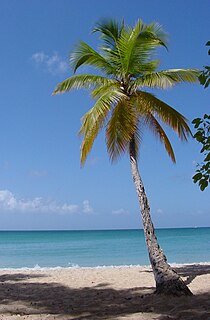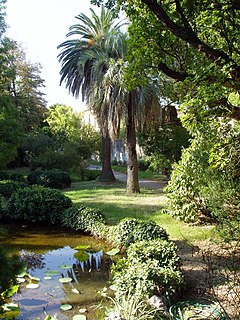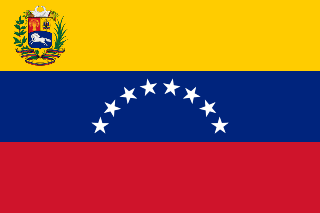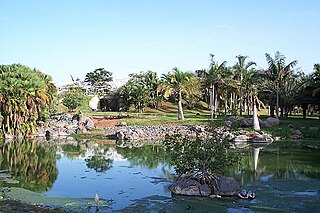
The Singapore Botanic Gardens is a 160-year-old tropical garden located at the fringe of Singapore's Orchard Road shopping district. It is one of three gardens, and the only tropical garden, to be honoured as a UNESCO World Heritage Site. The Botanic Gardens has been ranked Asia's top park attraction since 2013, by TripAdvisor Travellers' Choice Awards. It was declared the inaugural Garden of the Year, International Garden Tourism Awards in 2012, and received Michelin's three-star rating in 2008.

Calamus is a genus of the palm family Arecaceae. These are among several genera known as rattan palms. There are an estimated 400 species in this genus, all native to tropical and subtropical Asia, Africa, and Australia. They are mostly leaf-climbing lianas with slender, reedy stems. To aid scrambling some species have evolved hooks on the underside of the midrib, or more commonly by modified "pinnae" or tendrils in the form of stout, backward-pointing spines. These stems may grow to lengths of 200 metres.

Fairchild Tropical Botanic Garden is an 83-acre (34 ha) botanic garden, with extensive collections of rare tropical plants including palms, cycads, flowering trees, and vines. It is located in the city of Coral Gables, Miami-Dade County, Florida, United States, just south of Miami, surrounded at the south and west by Matheson Hammock Park.
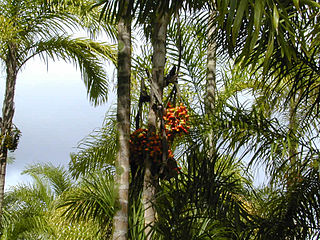
Bactris is a genus of spiny palms which is native to the Mexico, South and Central America and the Caribbean. Most species are small trees about 2 metres tall, but some are large trees while others are shrubs with subterranean stems. They have simple or pinnately compound leaves and yellow, orange, red or purple-black fruit. The genus is most closely related to several other spiny palms—Acrocomia, Aiphanes, Astrocaryum and Desmoncus. The fruit of several species is edible, most notably B. gasipaes, while others are used medicinally or for construction.
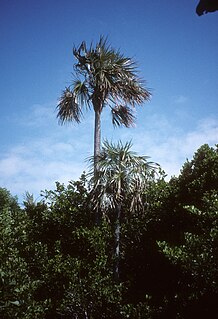
Coccothrinax is a genus of palms in the family Arecaceae. There are more than 50 species described in the genus, plus many synonyms and subspecies. A new species was described as recently as 2017. Many Coccothrinax produce thatch. In Spanish-speaking countries, guano is a common name applied to Coccothrinax palms. The species are native throughout the Caribbean, the Bahamas, extreme southern Florida and southeastern Mexico, but most of the species are known only from Cuba.

Calyptrogyne is a genus in the palm family (Arecaceae). The distribution of this genus is Central America, Colombia, and southern Mexico, with 11 of the 17 known species endemic to Panama. Calyptrogyne ghiesbreghtiana is the most widespread and best studied species in this genus.

The Montgomery Botanical Center, originally known as the Montgomery Foundation, is a nonprofit botanical garden and institution located at 11901 Old Cutler Road, Coral Gables, Florida. It collects seeds from wild plant populations worldwide, with an emphasis on palms and cycads. The garden is a scientific research facility, and not generally open to the public.
Karl Ewald Maximilian Burret, commonly known as Max Burret was a German botanist.

Caryota is a genus of palm trees. They are often known as fishtail palms because of the shape of their leaves. There are about 13 species native to Asia, northern Australia, and the South Pacific. One of the more widely known species is Caryota urens, the flowers of which are used to make one type of jaggery, and also to make palm wine. Caryota mitis is native to Indochina, but has become an invasive introduced species in the US state of Florida. They are also one of the few Arecaceae with bipinnate foliage. Many grow in mountainous areas and are adapted to warm mediterranean climates as well as subtropical and tropical climates.

The San Juan Botanical Garden, also known as the Botanical Garden of the University of Puerto Rico, is located in the Caribbean city of San Juan, capital of Puerto Rico. This lush 300-acre (1.2 km2) “urban garden” of native and exotic flora serves as a laboratory for the study, conservation and enrichment of plants, trees, flowers, grasses and many other plants. Seventy-five acres are landscaped and open to the general public as well as researchers.

Ceroxylon is a genus of flowering plant in the family Arecaceae, native to the Andes in Venezuela, Colombia, Ecuador, Peru, and Bolivia, known as Andean wax palms.
Anderson Park is a 20 hectare arboretum in the suburb of Pimlico in Townsville, Queensland.
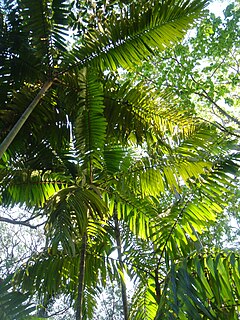
The Palmetum is one of three botanical gardens of Townsville, Queensland. The Palmetum is located in the suburb of Annandale, near the Ross River, James Cook University and the Townsville Hospital.

The Palmetum is a specialized botanical garden located in the Malakpet area, Hyderabad, in Telangana, which features only one family of plant: the palm.
Roystonea princeps, commonly known as Morass cabbage palm or Morass royal palm, is a species of palm which is endemic to western Jamaica.

Sabal causiarum, commonly known as the Puerto Rico palmetto or Puerto Rican hat palm, is a species of palm which is native to Hispaniola, Puerto Rico, the United States Virgin Islands, and the British Virgin Islands. As its common and scientific names suggest, its leaves are used in the manufacture of "straw" hats.
Climbing palms are genera in the family Arecaceae that grow as lianas. "Initially erect, the slender stems seek out trees for support and climb up into the forest canopy by means of recurved hooks and spines growing on the stem, leaves and inflorescences. In all climbing palms the leaves are pinnate and grow along the stem instead of forming a dense crown. The stems of climbing palms, more often referred to as canes, are solid in contrast to bamboo poles which are almost always hollow." "The majority of climbing palms are also clumping palms [and sympodial], sending out new shoots from [below ground as suckers]." "About 600 species of palms in [16] genera have a climbing growth habit. Most noteworthy is the genus Calamus--the largest genus in the palm family with approximately 350 described species--source of nearly all commercial rattan."
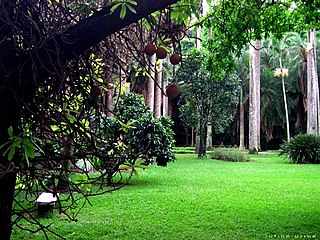
The Caracas Botanical Garden, also known as Central University of Venezuela Botanical Garden, is part of the University City of Caracas World Heritage Site.

